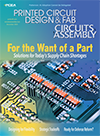News
MANKATO, MN – EMS firm Winland Electronics has signed a one-year agreement to manufacture a line of digital imaging products.
The company shipped $1.1 million of digital imaging products in the fourth quarter and has received a purchase order for an additional $1.1 million scheduled for shipment in early 2007.
The firm said it anticipates additional orders. The supply agreement is renewable in one-year terms.
The company shipped $1.1 million of digital imaging products in the fourth quarter and has received a purchase order for an additional $1.1 million scheduled for shipment in early 2007.
The firm said it anticipates additional orders. The supply agreement is renewable in one-year terms.
MILPITAS -- Top tier electronics manufacturing services provider Solectron reported November quarter sales of $2.99 billion, up 22% from the same quarter 2005. In its 10Q form, Solectron said its gross profit was up 10% to $149.4 million, while income from continuing operations fell sharply to $6.6 million from $20.2 million a year ago.
QINGDAO, CHINA -- Home appliance manufacturer Haier Group, one of China's largest OEMs, will purchase PC maker Founder Group, a deal that will make Haier the second-largest seller of PCs in China.
Founder reported sales of 7.39 billion yuan (roughly $92 million) in 2005. Haier had sales of 103.4 billion ($12.9 billion) yuan.
FRAMINGHAM, MA -- Taiwan's IT sales will hit $6.7 billion in 2007, International Data Corp.'s Taiwan branch forecasts.
The firm predicts sales of IT hardware, software and services in Taiwan next year will grow 2.8% from 2006.
The firm predicts sales of IT hardware, software and services in Taiwan next year will grow 2.8% from 2006.
ALMEIDA, CA -- The cost of manufacturing in China rose sharply last year, says analyst Charlie Barnhart of Technology Forecasters.
Barnhart, who develops case studies on procurement strategies, says a number of factors are pushing prices for electronics manufacturing services in China higher, and the trend is expected to continue.
"Chasing low-labor rates around the globe is not the answer," Barnhart wrote. He will produce a workshop on the topic on Jan. 17, in Chicago.
Barnhart, who develops case studies on procurement strategies, says a number of factors are pushing prices for electronics manufacturing services in China higher, and the trend is expected to continue.
"Chasing low-labor rates around the globe is not the answer," Barnhart wrote. He will produce a workshop on the topic on Jan. 17, in Chicago.
ATLANTA - UP Media Group seeks abstracts for PCB Design Conference East 2007, to be held Oct. 21-26 outside Research Triangle Park, NC.
The five-day conference program focuses on PCB design, engineering and manufacturing. The conference is comprised of a three-day technical conference and a Professional Development Certificate program of one-day and two-day courses. PCB East 2007 also includes a two-day (Oct. 23-24) exhibition of top industry vendors.
Suggested presentation topics include: high speed, high frequency and signal integrity; component placement; EMI/EMC analysis; thermal analysis; lead-free processes; RF and microwave design; packaging design; mixed-signal design; area arrays; FPGA design and implementation; embedded passives and active devices; flexible circuitry; HDI design and technologies; PCB design/layout basics; component library creation and management; design for manufacture, test and assembly; design (including analog, digital and power supplies); PCB fabrication; soldering; surface finishes; industry forecasts, and business and design/supply chain issues.
For consideration, please email course title, suggested course length, short description of the target audience, 100- to 300-word abstract and speaker bio(s) to Kathy Nargi-Toth (knargitoth@upmediagroup.com) by Feb. 5.
Papers and presentations must be noncommercial in nature and should focus on technology, techniques or methodology rather than on a company’s specific products.
The five-day conference program focuses on PCB design, engineering and manufacturing. The conference is comprised of a three-day technical conference and a Professional Development Certificate program of one-day and two-day courses. PCB East 2007 also includes a two-day (Oct. 23-24) exhibition of top industry vendors.
Papers and presentations of the following durations are sought for the technical conference: 30-minute paper sessions, one-hour lectures or panel sessions, two-hour workshops, and half-day (3.5 hour) seminars. Papers and presentations also are sought for a Professional Development Certificate program of in-depth, one-day and two-day technical tutorials.
Suggested presentation topics include: high speed, high frequency and signal integrity; component placement; EMI/EMC analysis; thermal analysis; lead-free processes; RF and microwave design; packaging design; mixed-signal design; area arrays; FPGA design and implementation; embedded passives and active devices; flexible circuitry; HDI design and technologies; PCB design/layout basics; component library creation and management; design for manufacture, test and assembly; design (including analog, digital and power supplies); PCB fabrication; soldering; surface finishes; industry forecasts, and business and design/supply chain issues.
For consideration, please email course title, suggested course length, short description of the target audience, 100- to 300-word abstract and speaker bio(s) to Kathy Nargi-Toth (knargitoth@upmediagroup.com) by Feb. 5.
Papers and presentations must be noncommercial in nature and should focus on technology, techniques or methodology rather than on a company’s specific products.
If selected, final papers and presentations will be due in April.
Press Releases
- Critical Manufacturing Partners with Canonical to Expand Cloud-Native Deployment Options for Manufacturers
- Heller Industries Becomes the Latest Partner to Join THE SMT FUTURE EXPERIENCE
- AIM Solder Signs New Distributor in Vietnam
- Variosystems launches AI platform for secure and connected supply chain services


